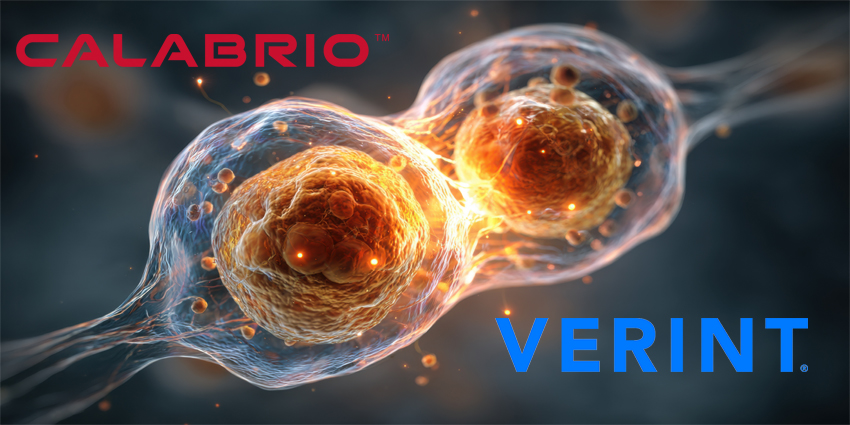Contact center workforce management (WFM) tools enable planners to create forecasts, manage schedules, support intraday management, and run reviews.
Some solutions marketed as “WFM” only cover some of these capabilities. The following ten providers offer solutions across each of these four cornerstones of workforce management.
As such, contact centers that are ready to finally move past Erlang Calculators and Excel spreadsheets can be sure that – by implementing one of these tools – they’re implementing a holistic solution.
1. NICE
NICE is the historical leader in contact center workforce optimization (WFO). In 2025, it remains a market frontrunner, delivering deep WFM and quality assurance (QA) tools, amidst its CCaaS charge.
In WFM, it continues to drive industry-first innovation, too. Consider its True to Interval (TTI) analytics solution. It logs contact center interactions in the interval they occur, not when they end.
A simple enough idea, but one that has proven effective in reducing the risk of understaffing and overstaffing.
Additionally, NICE bolstered its WFM portfolio by picking up Playvox in 2024.
Beyond that, the company has developed a reputation for delivering an easy-to-use interface, powerful ticket management tools, and solutions to actively improve employee experiences.
2. Verint
Verint is another traditional leader in WFM. Alongside this, it offers adjacent technologies, like QA and conversational intelligence solutions.
The vendor has pulled these together into a workforce engagement management (WEM) suite, enabling cross-application innovation.
Yet, nowadays, most of Verint’s innovation stems from its new specialized bots strategy, where it augments its portfolio – which includes its WFM tools – with agentic AI.
Consider its “TimeFlex” bot that enables agents to make unlimited schedule changes, without compromising operational efficiency.
Then, there’s the Verint Work Allocation Bot that extends WFM into the back-office, allocating work based on “customizable parameters” and “decision layers”.
As Verint blurts the term “CX automation” at every given opportunity, expect this bot-led strategy to continue.
3. Calabrio
Calabrio ONE demonstrates innovation across each of the four cornerstones of WFM.
For instance, its forecasting module automates demand predictions up to 60 days in advance using machine learning, while AI-driven insights simplify modifications.
Meanwhile, its dynamic scheduling auto-assigns shifts, optimizes breaks, and enables bulk editing, ensuring real-time adaptability.
There’s also real-time adherence to help managers monitor AUX codes, identify non-compliance, and snooze alerts when necessary.
Finally, agents can bid on shifts, move breaks, and manage schedules through an intuitive interface or mobile app.
Calabrio aims to innovate further by closing the gap between WFM and conversational AI, as signaled by its recent acquisition of Echo AI.
4. Peopleware
Formerly injixo, Peopleware is a suite of cloud-based workforce management tools with AI embedded throughout.
Its forecasting functionality is particularly noteworthy, with over 100 AI models. Contact centers can test these with historical data to spot the best fit for their environment. That might change across seasons and what-if scenarios.
Peopleware also excels at intraday management, with solutions for time and attendance tracking, time-off management, and dynamic schedule changes.
Moreover, it embeds educational tools into its system, providing organizations with an easy way to upskill and train teams constantly.
Ultimately, Peopleware is an intuitive ecosystem for contact center planners, with deep integrations and APIs for end-to-end automation.
5. Assembled
Assembled offers the full stack of conventional WFM software, layering over leading-edge innovation, like staffing scenario simulations.
Its thought leadership has won the company business with the likes of HubSpot, Mars, and Stripe.
Another example is its deep reporting capabilities, which house comprehensive dashboards, historical analytics, and real-time updates. Here, organizations can customize AI-fuelled metrics, ensuring they align with in-house definitions.
The company also offers dedicated tools for vendor management and performance management, allowing companies to build their own modular toolkit for contact center planning.
6. Aspect
Aspect is owned by Alvaria, a prominent cloud contact center provider that spun out its WEM technology in 2024.
Why? To make it available to service operations that leverage other CCaaS platforms with fewer native WEM capabilities.
WFM is a cornerstone part of those WEM capabilities. Indeed, Aspect offers all the foundational elements alongside flexible schedule management capabilities and deep integrations with external solutions.
These external solutions include CRM and HR solutions, allowing contact centers to democratize critical employee experience insights.
Aspect also touts its user-friendly design as a differentiator, allowing smaller companies to “easily” set up and customize the platform to their specific needs.
7. Dialpad
In 2024, Dialpad acquired Surfboard to move into the WFM space.
Surfboard prided itself on being more design-led than its competitors, with each group of its solution engineers having a dedicated designer who focused on product design and user experience.
Don’t expect that to change post-acquisition with Dialpad retaining Surfboard’s team.
That team may focus on bringing WFM together with Dialpad’s existing QA and conversational intelligence capabilities to deliver a WEM suite.
Another differentiator Surfboard claimed is in its culture of collaboration with buyers, offering long-term, close support. Hopefully, this will continue post-acquisition.
8. Zendesk
Best known for its suite of ticketing, customer service, and communication tools, Zendesk acquired Tymeshift in 2023.
Today, the company has built on that acquisition to deliver an all-in-one system that supports AI-driven forecasting and scheduling with predictive analytics.
Managers can also access live insights into agent activities, tracking performance and adherence to schedules. Plus, there are various agent self-service tools for shift management.
Moreover, the platform offers detailed reporting solutions for a comprehensive view of everything from productivity metrics to task distribution and engagement.
Since acquiring Tymeshift, Zendesk also acquired Klaus, the contact center QA and learning management solutions provider. Now, it’s pulling these solutions together with WFM into a WEM portfolio.
9. Genesys
Genesys Cloud CX WFM leverages AI-driven forecasting to optimize staffing, reducing both overstaffing and understaffing while controlling labor costs.
Its flexible scheduling tools allow managers to adjust shifts in real time based on data, employee preferences, and business needs.
Like NICE, Genesys can also offer seamless integration with its broader contact center ecosystem, providing a unified view of contact center operations, enhancing efficiency and performance tracking.
However, this is a solution geared to enterprises. It may require significant training, posing challenges for smaller teams with limited technical resources.
There are also potential integration challenges with non-Genesys systems. Nevertheless, its a deep WFM offering, compared to those offered by most CCaaS providers.
10. Eleveo
Eleveo leverages Google AI to help organizations accurately forecast and understand staffing needs and schedule multi-skill agents across channels.
The built-in intraday management tools are comprehensive, too. For instance, supervisors can monitor schedule adherence in real time and adjust schedules in seconds based on dynamic data, and provide feedback to staff.
Additionally, there are solutions to close the gap between planners and the agent population, such as performance report cards.
Ultimately, Eleveo aims to give business leaders and supervisors more control over team management without compromising employee experiences.
Final Thoughts
Finding the best contact center WFM tools can be complex, especially as contact centers look to do more with their employee experience data.
All of the options above offer something unique, from AI capabilities to broader integrations to democratize insight.
For more on how to weigh up these solutions, check out the article: Comparing Workforce Optimization Options: All-in-One or Best-Fit Solution?







